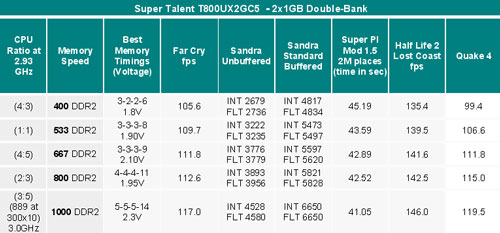
Original Link: https://www.anandtech.com/show/2124
Value DDR2-800 from Super Talent: Where Can You Go?
by Wesley Fink on November 29, 2006 12:05 AM EST- Posted in
- Memory
Super Talent DDR2-800 5-5-4
Many readers have been asking about low-priced DDR2-800 in recent weeks. As prices escalated in the past several months the search for value DDR2 became an economic necessity, but now that prices have moderated the bigger question is whether value DDR2 can deliver the performance many buyers are looking for, and save $100, $200 or even more to be used for a better video card or a faster CPU? To better answer that question Super Talent, a manufacturer of enthusiast memory, supplied a typical value part rated at DDR2-800.
Super Talent has several DDR2-800 rated parts, and they decided to provide their lowest priced DDR2-800 rated at 5-5-4 timings. With a price of just over $200, this Super Talent DDR2-800 certainly qualifies as a value 2GB kit. 2GB should be a good match for the soon-to-be-released Vista operating system, but if price is a huge concern in the system build, this Super Talent memory is also available as a 1GB kit with a pair of 512MB DIMMs.
This range of prices and configurations should certainly qualify the Super Talent DDR2-800 5-5-4 kits as a value product in any current memory comparison. With a rating of DDR2-800 the kits compete with lower rated 2GB kits at about the same price. However, the question still remains whether a step down to DDR2-800 will save a few bucks while delivering performance about as good as the top DDR2 memory.
Super Talent DDR2-800 Specifications
Super Talent was all but invisible in the desktop memory market until Joe James moved from marketing at Corsair to Super Talent. Since that time Super Talent has been pushing for visibility in the enthusiast desktop memory market, and the brand is appearing at a number of online etailers. A quick look at their website will show the heavy emphasis on flash products, which is why you may not have heard of Super Talent until recently. Still, the company has been making memory products for about 20 years, and the Super Talent design center is located in San Jose, California.
In our last review of Super Talent memory we complained about the amateurish packaging of Super Talent. It is clear that Super Talent is paying attention since the new packaging is greatly improved.
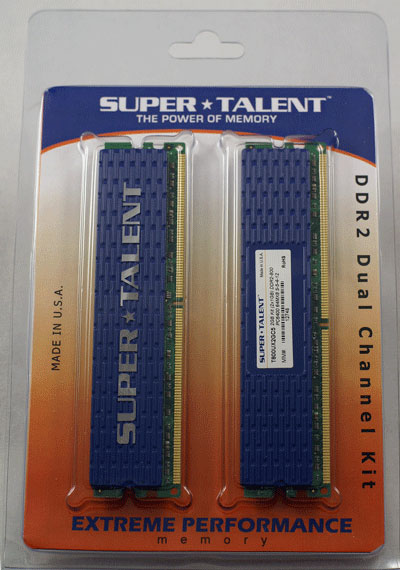
The crude packaging is gone and has been replaced by new designs with strong corporate identity. You can also see the attractive new heat spreaders that coordinate with the package theme. These are all clear indications that Super Talent is serious about competing in the desktop memory market.
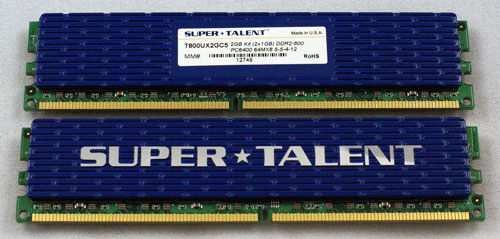
The T800UX2GC5 is a DDR2-800 2GB kit supplied with attractive blue heatspreaders. This is a value product rated at DDR2-800 and 5-5-4 timings. The matched pair of 1GB DIMMs sell in the low $200 range, but they are still identified on the ST website as a member of the overclocking series. Super Talent also offers another 2GB DDR2-800 kit rated at 4-4-3-8 timings at a price just below $300 (even less with the current rebate). The DDR2-800 5-5-4 and DDR2-800 4-4-3 DIMMs are both supplied as either 512MB or 1GB DIMMs, and as single DIMMs or two DIMM kits (2x512MB or 2x1GB).
We do not know which memory chips are used in building the Super Talent tested in this review. Performance suggests it is not Micron D9 chips or even Elpida memory chips. The memory is specified at the fairly slow 5-5-4 timings you expect to see in value DDR2-800.
| Super Talent T800UX2GC5 Memory Specifications | |
| Number of DIMMs & Banks | 2 DS |
| DIMM Size | 1GB |
| Total Memory | 2 GB |
| Rated Timings | 5-5-4-12 at DDR2-800 |
| Rated Voltage | 1.8V |
As you will see later in the review, Super Talent managed to handily outperform the rated memory specifications with just a modest increase in memory voltage.
Memory Test Configuration
DDR2 memory performance, in timings and required voltage, are equivalent on the AM2 and Core 2 Duo platforms. This was clearly illustrated in Conroe vs. AM2: Memory & Performance. However, the first generation of AM2 on-processor memory controller does not support any memory timings below 3, or memory speeds above DDR2-800, while both these features are supported on the Intel platform. Timings of 2 are available for RAS-to-CAS and RAS Precharge, and DDR2-1067 is a memory speed option on most Intel motherboards. The lack of extended memory timings and memory speeds makes it more difficult to test the newest high-speed DDR2 memories on an AM2 platform.
For these reasons, the Intel platform is the current AnandTech test platform of choice for DDR2 memory. The Core 2 Extreme processor, which has available speed multipliers both up and down, is the processor of choice. Both the Intel and NVIDIA chipsets for Intel Core 2 Duo Socket 775 processors provide the DDR2-1067 memory ratio option, as well as other intermediate values and values higher than DDR2-1067 with some high-end DDR2 memory. When changes are made in future AMD and Intel products the memory test platform will be examined again.
The ASUS P5W-DH is the latest 975X board in the ASUS family and it fully supports all the Core 2 processors. The P5W-DH Deluxe replaced the P5W-D2-E Premium used in past DDR2 reviews. A review of the updated ASUS P5W-DH Deluxe is available in the Conroe Buyers Guide.
Since the Core 2 Duo/Extreme processors run at a quad-pumped FSB of 1067 (base 266), instead of the FSB800 used on earlier Intel processors, the available options on the P5W-DH Deluxe at FSB1067 are particularly well-suited for benchmarking memory when a Core 2 chip powers the system.
| Memory Configuration Options/ASUS P5W-DH Deluxe Motherboard | ||||||||
| Auto | DDR2-400 | DDR2-533 | DDR2-667 | DDR2-711 | DDR2-800 | DDR2-889 | DDR2-1067 | |
| FSB-1067 | X | X | X | X | X | X | X | X |
| FSB-800 | X | X | X | X | X | |||
| FSB-533 | X | X | X | |||||
The memory test bench uses the following components:
| Memory Performance Test Configuration | |
| Processor | Intel Core 2 Duo X6800 (Dual core, 2.93GHz, 4MB Unified Cache) |
| RAM | 2x1GB Super Talent T800UX2GC52X1GB G.Skill DDR2-800 2x1GB Patriot DDR2-1066 2x1GB Super Talent DDR2-1000 2x1GB TEAM DDR2-1000 2 x 1GB Corsair CM2X1024-6400C3 2x1GB OCZ Ti Alpha PC2-8000 VX2 |
| Hard Drive | Hitachi 250GB SATA2 enabled (16MB Buffer) |
| Video Card | 1 x EVGA 7900GTX - All Standard Tests |
| Video Drivers | NVIDIA 91.47 |
| CPU Cooling | Tuniq Tower 120 |
| Power Supply | OCZ PowerStream 520W |
| Motherboard | ASUS P5W-DH Deluxe (Intel 975X) |
| Operating System | Windows XP Professional SP2 |
| BIOS | AMI 1407 (October 2, 2006) |
Core 2 Duo is as much as 35 to 40% faster than the earlier Intel Presler. Therefore the only results shown in this review are DDR2 memories tested on the X6800 (Core 2 Extreme) platform.
Stock Memory Performance
Most Intel Socket T (Socket 775) motherboards provide a wide range of memory ratios that match available DDR2 memory. End-users can select the memory ratio that matches their DDR2 memory speed. Our memory testing begins with the same approach. We first test all of the stock ratios at the fastest stable timings we can achieve at the given ratio. With these ratios, CPU speed remains the same at 2.93GHz in our memory test bed, and memory speed is varied by selecting different ratios.
DDR2 memory is then pushed from the highest stock ratio that could be achieved in testing - in this case 889 (3:5) - to the highest FSB speed at the stock multiplier. We could not reach DDR2-1067 with this value Super Talent DDR2-800, so we settled for the intermediate ratio of 889. The system was then pushed to DDR-1000, which was the highest stable speed reached that ran our complete test suite. We were able to boot at speeds much higher than 1000, and we could actually navigate the boot screen up to DDR2-1050, but the system was not stable in Windows and could not complete our test suite, even at the highest 2.4V supported by the ASUS board. Other systems may achieve higher test results with more voltage.
There are some potential downsides to this approach to memory testing. With the memory controller in the chipset, instead of part of the processor as in AM2 systems, there is a small performance penalty for speeds other than a 1:1 ratio (DDR2-533 in this case). The actual performance penalty is in reality very small and it has minimal impact on test results. As a result memory scales nicely through the various speed options.
At DDR2-800 the memory completed our benchmarks at 4-4-4-11 timings at just 1.95V. This is significantly faster than the rated 5-5-4-12 timings. Most boards can easily supply 1.95V, but if your board has a fixed memory voltage you may need to use slower timings for complete stability with this memory. DDR2-667 similarly required 2.10V to achieve 3-3-3-9 timings. If you can't supply 2.1V you will likely need 4-4-3-9 or slower timings at stock 1.8V.
Many buyers of value DDR2-800 memory will not have a motherboard that can supply voltages like the highest 2.30V required in our testing at DDR2-1000. If your top available voltage is less than 2.3V you will not be able to achieve DDR2-1000 performance with this memory. Top results at stock voltage will likely be in the DDR2-900 range at the rated 5-5-4-12 timings
The performance results found in our testing give most every buyer some choices when using this value Super Talent DDR2-800 in their system. If their board is voltage limited, the memory is still usable at slightly slower timings. If the board supplies a very wide voltage range, then you can likely squeeze better timings from this memory with higher voltage. With air cooling, however, the best you can expect to achieve is around DDR2-1000.
Memory Bandwidth Scaling
Memory bandwidth normally improves with increases in memory speed and reductions in memory timings. This is best illustrated using Performance Scaling charts instead of the bar charts for individual speeds that were used in past memory reviews.
Since the results for high-end memory were so close at all tested speeds, the scale range was reduced to better show the small differences in these memory benchmark results. Please keep this in mind when viewing the charts, since a normal zero scale would make performance differences appear much smaller than these expanded scale charts. Values for the tested memories are included below each chart for reference.
To evaluate memory bandwidth SiSoft Sandra 2007 Professional is used to provide a closer look at scaling for fast DDR2 memory.
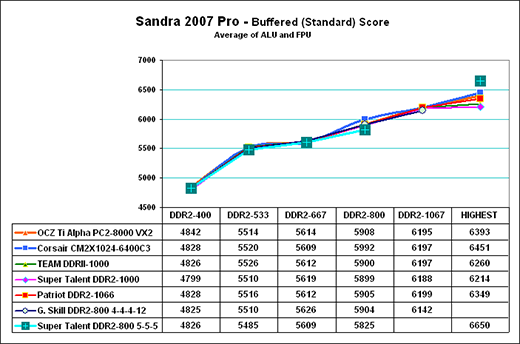
The most widely reported Sandra score is the Standard or Buffered memory score. This benchmark takes into account the buffering schemes like MMX, SSE, SSE2, SSE3, and other buffering tools that are used to improve memory performance. Buffered bandwidth performance of the Super Talent memory was virtually the same as the previously tested high-end DDR2 memory at DDR2-800. The Super Talent could not reach DDR2-1067 with stability and topped out at DDR2-1000. Performance at DDR2-1000 cannot be directly compared to other top-end results since the system is modestly overclocked using a DDR2-889 ratio at a FSB setting of 300 where the other memories used a DDR2-1067 ratio.
The Buffered benchmark does not correlate well with real performance differences in games, so our memory bandwidth tests have always included an Unbuffered Sandra memory score. The Unbuffered result turns off the buffering schemes, and we have found the difference in Unbuffered results correlate well with real-world performance differences.
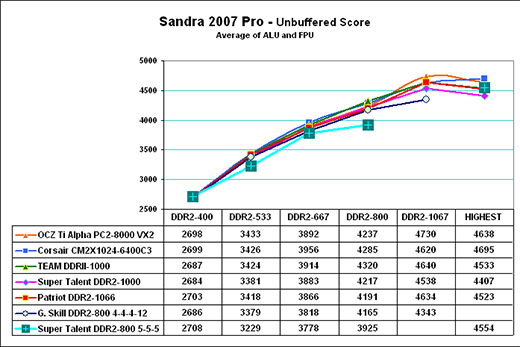
In Unbuffered tests the Super Talent mirrors the best memory tested to DDR2-800, but at a slightly lower performance due to the slower timings. There is no DDR2-1067 performance with the Super Talent and the highest stable speed, DDR2-1000, required a DDR2-889 memory ratio at a bus overclock to 300. It is worth pointing out, however, that memory bandwidth, both buffered and Unbuffered, continue to increase with memory speed.
We also compared results with Version 1.5 of Super Pi - comparing the time to calculate 2 million places of Pi at the different memory speeds. This benchmark measures pure number crunching.
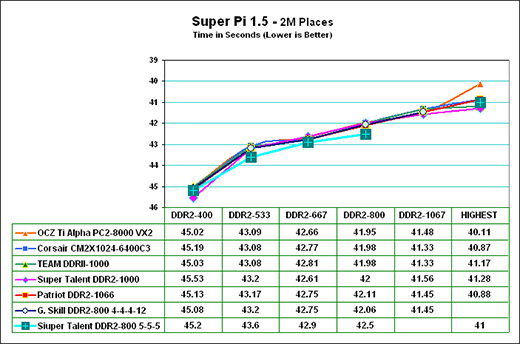
Super Pi results continue to improve all the way to the highest speed that could be reached with stability with each memory. The second result that stands out is how very close the results with all the memories really are.. All four top-end memories perform very similarly. . The Super Talent drops off a bit at the top and bottom due to slightly slower timings in those ranges. The mid-range G. Skill performs similarly until DDR2-1067 where slower timings finally provide a penalty. The Super Talent DDR2-800 value memory drops off a bit at DDR2-800 due to slightly slower timings, but the performance is still remarkably close to the best we have tested. While performance is very close, Super Pi scaling charts continue to show the useful sensitivity of Super Pi as a measurement of memory performance
Game Performance Comparison
Real-world benchmarks - specifically gaming benchmarks - provide the most useful measure of memory performance if you keep in mind what they represent. Memory is just one small part of overall gaming performance, and the AnandTech benchmarks keep everything the same except memory speed. Even the CPU speed is kept constant (except for the Highest Speed (overclocking) test). As a result performance improvements in FPS are very small because the only factor influencing the test results is memory speed. Many factors affect system performance, and memory speed is just one of those factors.
Results for high-end memory were very close at tested speeds. Therefore, the scale range was reduced to better show the small differences in these memory benchmark results at each speed. Please keep this in mind when viewing the charts. A normal zero scale would make performance differences appear much smaller than these expanded scale charts. Values for the tested memories are included below each chart for reference.
The AnandTech memory test suite uses Far Cry, Half Life 2 and Quake 4 for memory testing because these games are sensitive to memory performance and they are generally not GPU bound.
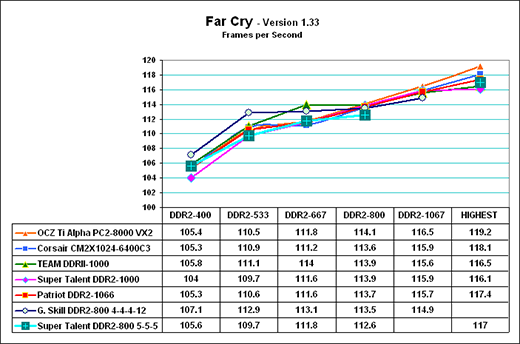


We have said before that the Core 2 Duo chips are not memory starved, and if you look closely you will see that the real world performance of this value RAM is only a bit slower in games than tested memory that costs twice as much. The Super Talent can't reach DDR2-1066, but with a modest overclock at DDR2-1000 the performance is still competitive with the top DDR2 memory we have tested at speeds to DDR2-1000 or higher.
There is no doubt the best memory gives you a few frames per second better gaming performance at all speeds, and it will also allow your system to reach higher CPU overclocks due to the added latitude of the memory. However, the real world difference between 4-4-4 timings and 3-3-3 timings at DDR2-800 is quite small.
It is interesting that memory is varying from 3-2-2-6 timings at DDR2-400 all the way to 5-5-5-15 timings at DDR2-1000. Despite the rapid drop in memory timings, all three games continue to show improvement in frame rates as memory speed increases. Put another way, performance continues to improve as memory speed increases. The Super Talent T800UX2GC5 performance was pretty much as expected. Results were virtually the same as the best DDR2 we have tested to DDR2-800, with a slight drop off due to slower timings at DDR2-800. The Super Talent could not reach DDR-1067, but it did perform well to DDR2-1000 with an 889 ratio pushed to a 300 bus setting (from the stock 266). Memory speed can definitely improve system performance, but not to the extent of an upgraded video card or a higher speed processor.
Overclocking Performance (Highest Ratio at Highest Speed)
The Super Talent DDR2-800 value memory performed extremely well to its rated speed of DDR2-800. It also was able to reach beyond rated speed to DDR2-1000 at the DDR2-889 memory ratio, but the Super Talent could not manage stable performance at the next standard speed of DDR2-1066. While this overclocking performance is the worst of the seven tested memories, keep in mind that the Super Talent DDR2-800 is the only value memory tested so far. This is outstanding performance for a value memory rated at DDR2-800 5-5-4.
With a maximum available voltage of 2.4V we could not reach above DDR2-1000. In fact we needed just 2.3V to reach a stable DDR2-1000 and additional voltage did not help extend overclocking.. Since value memory will likely be used on boards that supply less memory voltage than 2.3V, it is likely the top speed at lower voltages will be lower than DDR2-1000.
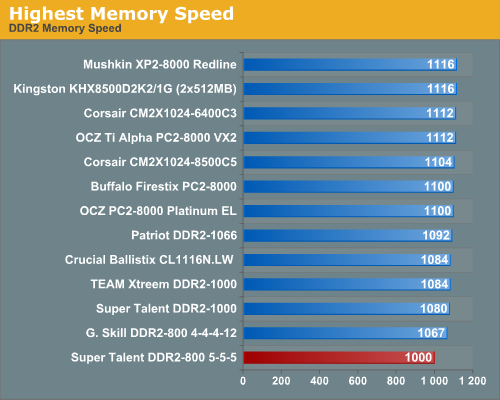
A value DDR2-800 memory that can reach to DDR2-1000 should be considered excellent performance. However, it is also very important for potential buyers of this value memory to take notice that the Super Talent reaches its rated DDR2-800 speed at a stock 1.8V, and it reaches significantly faster timings of 4-4-4 at a modest 1.95V which many low-cost boards can supply.
Final Words
All of the seven DDR2 memories we have previously tested have been based on Micron D9 memory chips. The best DDR2 memory we have tested is able to run at DDR2-800 3-3-3 timings and DDR2-1066 at 4-4-3. Performance at these settings is the best we have seen for DDR2, and they remain the standard against which other DDR2 memory is measured. It is worth repeating that all of the best DDR2 memory we have tested has been built with Micron memory chips, which have set the pace for high-end DDR2 memory performance.
The Super Talent DDR2-800 5-5-4, which is the subject of this review, is not built with Micron chips, it is not top-rated, and the price is definitely in the value segment. So what do you get then, with a Value DDR2-800 designed to sell for less than half the price of the top DDR2 memory available?
You get a lot more than you might expect with the Super Talent. For starters it runs DDR2-800 at 5-5-4 timings at the default 1.8V available on any Socket T or AM2 motherboard. This is something the top-end memory really can't do, since it is generally rated for performance at a higher DDR2 voltage. With just a little more voltage on the Super Talent T800UX2CG5 - a push to 1.95V - you can run stable 4-4-4-12 timings at DDR2-800. At those timings you will give up a few frames per second in games compared to 3-3-3 DDR2-800 timings, but the real performance difference is extremely small.
The Super Talent also will not perform with stability at DDR2-1067, something every other memory in our high-end testing has achieved. Again, this is a value memory and it will run at DDR2-1000, which is frankly outstanding performance for any memory that falls into the value category. The loss of performance at DDR2-1000 compared to DDR2-1067 to 1100 is very small. The biggest handicap might be small crimps in overclocking where you will need lower memory ratios to reach high CPU overclocks on the 965/975 Intel chipsets or the NVIDIA 680i. A modestly overclocked DDR2-1000 can all but match performance at 1066/1100 in the games most are running today.
The bottom line in all our results is that yes, the best DDR2 memory will give you the best performance. If absolute top performance is your goal then choose a memory that can do 3-3-3 at DDR2-800 and 4-4-3 at DDR2-1067. Your reward will be the best memory performance and highest frame rates you can achieve with any memory. However, if your concern is bang for the buck, you will be perfectly fine choosing a memory like Super Talent DDR2-800 5-5-4. Game performance will be only slightly slower, and you can more than make up for any small performance penalties by putting your savings towards a better video card or a faster CPU.
In the end the Core 2 Duo (and to a lesser extent the AM2) are not particularly memory bandwidth starved in present configurations. As a result the real advantages of faster memory are much smaller than we have seen in past architectures. You can take advantage of this fact by choosing somewhat slower memories with the knowledge that the real-world performance loss will be very small.
The Super Talent T800UX2CG5 is an excellent example of the kind of price compromises that make sense when total system cost is a big concern. If you are working within a tight budget, the Super Talent makes good sense as a value memory that will minimally impact performance, allowing the $100 to $200 savings to go toward a video card upgrade or CPU upgrade.
The Super Talent is certainly not the only good value choice and we will be testing others in the near future. Our advice would be to make sure your value memory choice can deliver solid performance at DDR2-800. Certainly the ability to do 4-4-4 or even better timings is desirable. Then look at where the memory tops out in overclocking tests. There are some good value products starting to appear in the DDR2 memory market and we have no doubt that many more are on the way. The Super Talent T800UX2CG5 is an outstanding choice where value and performance both matter.

